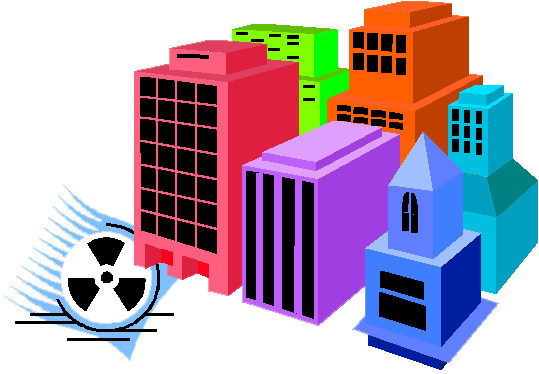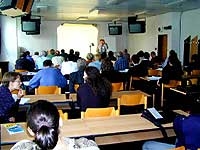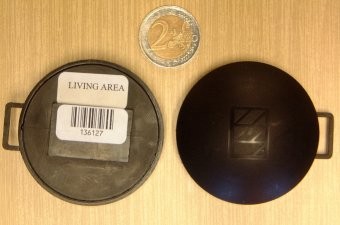Back
to Top
Back
to Top
Back
to Top
Back
to Top
Back
to Top
Back
to Top
Back
to Top
Back
to Top
Back
to Top
Back
to Top
Back
to Top
Back
to Top
Back
to Top
Back
to Top
Back
to Top
Back
to Top
Back
to Top
Back
to Top
Back
to Top
Back
to Top
Back to Top
Back to Top |
NORM, Radon Gas, Radon Activity
&
Protection from Radon in Buildings

-
NORM (Naturally Occurring Radioactive
Materials)
These are naturally occurring
radioactive elements in the 'natural' and 'built' environments.
Long-lived elements of interest include uranium, thorium,
potassium, and any of their respective radioactive decay products
such as radium and Radon.
Some of these elements have always been, and continue
to be, present in the earth's crust, and within the tissues
of all living beings.
Exposure to NORM is often increased by human activities, e.g.
burning coal and using fertilisers.
Radon Activity in Buildings - NORM
Classification
| 800 Bq/m3 and higher |
Implement a Radiation Protection
& Management Strategy |
| 150 Bq/m3 - 800 Bq/m3 |
Implement a Radon Protection
Strategy |
| 50 Bq/m3 - 150 Bq/m3 |
An issue of Liability for
building designers and 'workplace' employers within
the European Union ...... see the Precautionary
Principle and the mandatory EU Objective
of 'health protection'.
Implement a Radon Protection Strategy
|
-
-
The Health Effects of Exposure to Indoor Radon
Link to the US EPA WebSite & information about
the BEIR VI Report
Also see our WebPage on Building Related Ill-Health
-
-
Radon Activity in Buildings
To Protect Human Health ...... Radon Activity (incl. Rn-222, Rn-220,
RnD) should, on average, fall within the range of 10-40 Bq/m3,
but should at no time exceed 60 Bq/m3.
-
-
-
-
-
-
Indoor Air Quality (IAQ)
& Proper Ventilation of Buildings
A Good 'Top-Level' Performance Indicator :
Carbon Dioxide concentrations in a building should not
significantly exceed
average external levels - typically within the range of
300-500 parts per million (ppm) - and should at no time exceed
800 ppm.
-
-
Indoor
Positive Pressurization System (Radon)
Specified typically, although not always, for use in existing
buildings.
-
Water
Supplies to Buildings & Radon Emissions
Maximum Contaminant Level (MCL) for Radon (Rn-222) in water supplied to building interiors,
whether drinking or non-drinking - 150 Bq/litre.
Also see information on the Radon EuroCode above.
-
Building Products / Materials & Radon Emissions
Maximum Contaminant Level (MCL) for Radium (Ra-226) in building products
and materials - 300 Bq/Kg.
Also see information on the Radon EuroCode above.
-
Geological & Radon Monitoring / Testing Services
Link to our Colleagues in Prague, the Czech Republic ... Radon
vos
Link to our Colleagues in Bonn, Germany ... Kemski & Partner - Geologen
-
- Critical Issues of Design & Construction in the European Union
(Click to Download PDF File, 241kb)
Oral
Presentation by C J Walsh
3rd European Symposium on Protection against
Radon
Liege, Belgium / 10th - 11th
May 2001 |
-
 |
 |
| Workshop |
Visit
to National Authority for Nuclear,
Biological & Chemical Protection |
-
| Presentation
by C J Walsh |
Irish
National Radon Forum (ERRICCA-2)
Dublin, Ireland / 16th September 2002
&
6th International Workshop on Geological Aspects
of Radon Risk Mapping
Prague, Czech Republic / 20th - 24th
September 2002
|
Radon
Gas, Radon Activity & Protection of Buildings
| 1. |
What is Radon Gas ?
Radon
is all around us as part of our environment - in the soil,
the water, and in the air. It is an invisible, natural radioactive
gas. It is odourless and tasteless. In order to detect the
gas, a measuring device must be used.
Radon
becomes a health hazard if it is allowed to accumulate in
buildings.
Radon
is a proven human carcinogen. In 1988, it was given a Group
1 Classification by the World Health Organization
(WHO/IARC Monographs Programme, Vol. 43 1988, p.173) ......
'
There is 'sufficient evidence' for the carcinogenicity of
radon and its decay products in humans, i.e. a causal relationship
has been established between exposure to these agents, the
exposure circumstance and human cancer. That is, a positive
relationship has been observed between the exposure and cancer
in studies in which chance, bias and confounding could be
ruled out with reasonable confidence.'
Radon
is a major cause, second only to cigarette smoking, of lung
cancer deaths.
Radon
is not normally considered to be a 'contaminant'.
However,
in the case of water supplied to the interiors of buildings,
radon must be regarded as a 'contaminant'. Although high concentrations
of radon in water have an adverse effect on human health,
the radiation dose to the body due to inhalation of radon
gas released from the water is usually more important.
Radon
must also be regarded as a 'contaminant' in building materials.
|
| 2. |
Radon
Activity & Accumulation
Radon
(Rn-222), a chemical element with an Atomic Number of 86
and also a heavy radioactive gas of the Noble Gas Group
on the periodic table, is generated by the radioactive decay
of Radium (Ra-226). It is colourless, odourless, tasteless,
and with a density (1 atm / 0°C) of 9.73 g/litre is 7.5
times heavier than air, and more than 100 times heavier than
hydrogen. The gas liquefies at -61.8°C, and freezes
at -71°C. Upon further cooling, solid radon glows
with a soft yellow light which becomes orange-red at the temperature
of liquid air (-195°C).
To prepare
concentrated samples of radon gas, a supply of radium is placed
within a glass vessel in aqueous solution, or in the form
of a porous solid from which the gas can readily flow.
At intervals of a few days, the accumulated radon is pumped
off, purified, and compressed into a small tube, which is
then sealed and removed. The tube of gas is a powerful
source of penetrating gamma radiation / particles, which comes
mainly from one of radon's decay products, Bismuth-214 (Bi-214).
In the past, such tubes of radon were used for radiotherapy
and radiography.
Examine
the Periodic Table of Elements
Natural Radon, however, consists
of three isotopes, one from each of the three natural radioactive
disintegration series (uranium, thorium, and actinium). The
longest lived isotope, Radon-222
(alpha emitter of 3.823 day half-life), discovered in 1900
by the German chemist Friedrich E. Dorn, arises in the uranium
series. The name radon is sometimes reserved for this
isotope in order to distinguish it from the other two natural
isotopes, called 'thoron' and 'actinon' because they originate
in the thorium and actinium series, respectively.
The gas
thoron, Radon-220 (alpha
emitter of 55.6 second half-life), was first observed in 1899
by the English scientists R. B. Owens & Ernest Rutherford,
who noticed that some of the radioactivity of thorium compounds
could be blown away. The gas actinon, Radon-219
(alpha and gamma emitter of 3.92 second half-life), was found
in 1904, independently by Friedrich O. Giesel & Andre-Louis
Debierne, to be associated with actinium.
See Table
B, Annex I on Page 23 of European Union Council Directive
96/29/Euratom for a listing of the radioactive decay product
groupings of U-238, Th-232 and Ra-223.
|
| 3. |
Adverse
Health Effects from Radon (incl. Rn-222, Rn-220, RnD)
Figure
1 shows how two isotopes
of natural radon, Rn-222 and Rn-220, decay progressively
to a series of 'decay products' ( RnD ) . It is
these products, and not the radon gas itself because
it is inert, which first attach themselves to minute
particles suspended in the air, i.e. aerosols, depending
on ventilation in a building space, and on aerosol
size and concentration. A small proportion of decay
products will remain in unattached form.

A
significant danger to human health arises from the
inhalation of these continuously decaying products,
which are carried by radon gas and aerosols, into
a person's lungs. The radiation dose to lung tissue
is dominated by alpha particle emissions from the
decay products which then become attached to the lung
linings ; damage to sensitive cells is caused,
and the probability of cancer developing increases.
When
radon is permitted to accumulate in a building, e.g.
in an internal Radon Vent Pipe, a source of penetrating
gamma particle radiation is created and serious adverse
effects on human health may result. Exposure to
elevated levels of the gas may also be implicated
in the occurrence of other cancers, such as leukaemia
in children.
As
with prolonged exposure to the radiation from any
form of ionization activity, genetic and human fertility
damage will occur.
|
| 4. |
European
Union Legislation
The
1997 Amsterdam Treaty (97/C 340/01) - Paragraph
3 of Article 95 of the consolidated version of the
Treaty establishing the European Community (97/C 340/03)
- states ........
'
The Commission, in its proposals envisaged in paragraph
1 concerning health, safety, environmental protection
and consumer protection, will take as a base a high
level of protection, taking account in particular
of any new development based on scientific facts.
Within their respective powers, the European Parliament
and the Council will also seek to achieve this objective.
'
The
relevant secondary E.U. legislation is Council Directive
96/29/Euratom , of 13th May 1996, which
lays down basic safety standards for the protection
of the health of workers and the general public against
the dangers arising from ionizing radiation. This
Directive should have been implemented by all Member
States before 13th May 2000 (Article 55).
|
| 5. |
Target
Health Objective for Those Involved with Buildings
The World
Health Organisation, in the preamble to its Constitution,
defines 'health' as ........
'
a state of complete physical, mental and social
wellbeing, and not merely the absence of disease
or infirmity '.
Therefore,
within the European Union the objective must be to
achieve a sufficiently low level of radon, or radon
associated, ionization activity in the interior spaces
and superstructure construction cavities of
all buildings - such that
a significant hazard to human health
is not posed. Based
on the approach taken in U.S. Federal Legislation, a
target human health level, which lies within the range
of 10 - 40 Bq/m3, should be achieved.
|
| 6. |
Harmonized
European Vocabulary
| Activity
:
(EU Directive 96/29/Euratom) |
The
activity, A , of an amount of a radionuclide
in a particular energy state at a given time is the
quotient of dN by dt, where dN is the expectation value
of the number of spontaneous nuclear transitions from
that energy state in the time interval dt : A = dN
/ dt .
The
unit of activity is the becquerel. |
| Becquerel
:
(EU
Directive 96/29/Euratom) |
The
special name of the unit of activity. One becquerel is
equivalent to one transition per second : 1 Bq = 1
s -1. |
| Health
Detriment :
(EU
Directive 96/29/Euratom) |
An
estimate of the risk of reduction in length and quality
of life occurring in a population following exposure to
ionizing radiations. This includes loss arising from somatic
effects, cancer and severe genetic disorder. |
Intervention
:
(EU Directive 96/29/Euratom) |
A
human activity that prevents or decreases the exposure
of individuals to radiation from sources which are not
part of a practice or which are out of control, by acting
on sources, transmission pathways and individuals themselves.
|
Ionizing
Radiation :
(EU Directive 96/29/Euratom) |
The
transfer of energy in the form of particles or electromagnetic
waves of a wavelength of 100 nanometer or less, or a frequency
of 3 x 1015 Hertz or more, capable of producing
ions directly or indirectly. |
Natural
Radiation Sources :
(EU Directive 96/29/Euratom) |
Sources
of ionizing radiation from natural terrestrial or
cosmic origin. |
| Natural
Stack Effect : |
The
normal, upward convective movement of air inside
a building which results from warm / heated air
rising and venting to the exterior at higher
levels through design openings and gaps in a
building's super-structure, thus causing an indoor
pressure lower than that externally, and that
in the soil at foundation level. |
| Passive
Radon Extraction : |
A measure, relying solely on 'natural stack
effect', to extract soil gases from beneath
the floor construction of a building at foundation
level, to a position externally where they will
no longer cause harm, by means of a vertical
vent pipe which directly connects the sub-floor
construction with the exterior and passes through
the heated spaces of a building.
The
effectiveness of 'passive extraction' is intermittent
only, and is therefore unreliable. |
Radioactive
Substance :
(EU Directive 96/29/Euratom) |
Any
substance that contains one or more radionuclides
the activity or concentration of which cannot be
disregarded as far as radiation protection is concerned.
|
| Radon
Soil Gas Control System : |
A measure designed to control the natural movement
of radon soil gas (incl. Rn-222, Rn-220, RnD) in
the vicinity of a building at foundation level.
|
| Radon
Protection : |
The use of building design, construction, services,
systems, personnel and equipment in order to control
and reduce indoor radon activity (incl. Rn-222,
Rn-220, RnD) to a target human health level of
10 - 40 Bq/m3. |
| Radon
Resisting Barrier : |
A
radon resisting membrane, or membrane assembly, which
is capable of withstanding hydrostatic pressure. |
| Radon
Resisting Membrane : |
A
continuous membrane, properly installed on site,
the function of which is to resist the passage
of radon soil gas (incl. Rn-222, Rn-220, RnD)
into a building.
The
radon permeability of a 'radon resisting membrane'
shall not exceed a figure, taking into account
measurement uncertainty,
of 10 x 10-12 m2 / s . |
|
Radon Vent Pipe (RVP) / Air Feed Pipe
(AFP) : |
A
gas sealed vertical pipe which directly connects
a horizontal network of sump(s) and pipework, in
the sub-floor construction of a building at foundation
level, directly with an externally located open
terminal unit at roof or other high level, for
the purpose of feeding radon free air to a 'pressurization
system' , or venting radon from a 'de-pressurization
system' to a position where it will no longer
cause harm. A
Radon Vent Pipe / Air Feed Pipe should be colour
coded, or otherwise clearly marked, to warn the
building's users against tampering or interference. |
| Soil
Gases : |
The
gases present in soil, one of which will naturally
be radon (incl. Rn-222, Rn-220, RnD). |
| Sub-Floor
De-Pressurization (Active) : |
A
measure designed to extract radon soil gas from
beneath the floor construction of a building at
foundation level, to a position externally where
it will no longer cause harm, by means of a
fan and vertical vent pipe assembly which reduces
the sub-floor pressure relative to indoor pressure.
|
| Sub-Floor
Pressurization System (Active) : |
A
measure designed to create and maintain a safe,
i.e. radon-free, buffer zone beneath the floor
construction of a building at foundation level,
by using outdoor air taken from roof level, or
other high level, by means of a fan and vertical
feed pipe assembly.
In
the event of fan breakdown or failure, this system will
temporarily 'failsafe', and revert to Passive Radon
Extraction.
|
| Sub-Membrane
De-Pressurization System (Active) : |
A
measure designed to extract radon soil gas from
beneath a properly installed radon resisting membrane,
to a position externally where it will no longer
cause harm, by means of a fan and vertical
vent pipe assembly which reduces the sub-membrane
pressure relative to the space, cavity or void
pressure above the membrane.
This
system is typically used in suspended ground
floor construction. |
| |
|
|
| 7. |
Some
National Approaches and Findings [
1 ]
In
Sweden, a simple three-fold radon risk classification
for ground, based on geology, soil permeability and
soil gas radon measurement, has been developed. This
system, together with airborne gamma spectrometry surveys,
is used to produce 1 : 50,000 'provisional radon
risk maps'. By 1987, approximately 60% of the country
had been mapped. Where the soil cover is less than
2 metres thick over bedrock geology it is deemed
to be high risk, and ground measurements are made
of radon concentrations even if the airborne survey
reveals little radioactivity. Detailed radon surveys
are usually made before building.
The
United States is divided into three zones indicating
radon activity levels of less than 75 Bq/m3,
between 75 - 150 Bq/m3, and areas with
greater than 150 Bq/m3. The Environmental
Protection Agency, however, recommends that all
houses are tested for radon concentrations, regardless
of location within the country, since very high levels
have been found in each zone. Surveys of radon
soil gas, for example, around the city of Dunnellon,
in Florida, have ranged from 2,500 to 338,000 Bq/m3.
|
| 8. |
Radon
Measurement Uncertainty [ 6 ]
( i )
Variations With Time
Concentration
variations of radon and its decay products (RnD) occur
on many time scales, from hourly to annually, and
depend on seasonal factors and weather conditions,
building characteristics, operation of building heating
and cooling systems, building user lifestyles, source
relative strength, etc. Usually, concentrations are
higher in the evening and night than in the late
morning and early afternoon, and higher in the winter
than in the summer. However, it is not yet possible
to predict these variations with accuracy.
( ii )
Variations With Measurement Duration
The
longer the duration of a measurement the lower in
general is its variability : individual very
short-time measurements ( ~ minutes or a few hours )
can show variations higher than a factor of 10.
Measurements lasting a few days generally show variations
less than a factor of 10, while the seasonal variations
found in measurements of six months duration are usually
well within a factor of 5. Annual variations are
well within a factor of 2, e.g. measurements carried
out for a 5 year period in 40 residences in Grand
Junction ( Colorado, USA ) show a mean coefficient
of variation of approximately 22% . Because of the
magnitude of these variations, one year measurements
are considered the best compromise to estimate the
'average' value.
( iii
) Measurement Accuracy
Measurement
detectors / instruments have to be first of all calibrated,
then checked frequently. Periodic participation in
measurement intercomparisons is also to be recommended.
Calibration measurements are usually performed in a
'radon chamber', in which a known quantity of radon
is introduced. In general, the calibration of radon
decay products is more difficult than the calibration
of those for radon, due to many reasons, one of
which is that there is no primary standard for radon
decay products.
( iv )
Measurement Precision
Precision is assessed by replicate measurements, i.e.
exposing many detectors at the same time to the same
concentration. This allows an estimate to be made
of the coefficient of variation of the detectors at
that value of concentration. A periodical check on
precision should always be made.
In
Ireland, for example ...
 RPII RPII
Measurement
Uncertainty of the standard Alpha Particle
Etched-Track Detector distributed by the Radiological
Protection Institute of Ireland (RPII) is as follows:
| under
laboratory conditions : |
in
the order of .... |
+/-
10 % |
| under
tightly controlled site conditions : |
in
the order of .... |
+/-
20 % |
| under
typical conditions of use : |
in
excess of ...... |
+/-
30 % |
Unfortunately, until the RPII includes proper statements of Measurement Uncertainty
in its Test Reports .... our Architectural Practice ....
- cannot recommend any RPII Radon Testing Services ;
and
- will not accept any RPII Test Reports as proper evidence of Radon Test results.
See our Technical Guidance Notes.
|
| 9. |
Some
General Guidelines on Construction Detailing
( a ) To Reduce Radon Ingress
- use low-permeability building
products and materials, e.g. solid rather than cavity
concrete blocks with all vertical and horizontal
joints properly filled ;
- ensure
that all designed cavities are effectively gas sealed
to indoor spaces ;
- use
low-permeability construction techniques, e.g. in-situ
mass concrete with steel reinforcement to limit shrinkage
/ movement cracking ;
- avoid
construction which has too many joints or openings
;
- design
and detail construction for controlled movement ;
- limit
numbers of service penetrations and other openings
in ground slabs ...... design for grouping of services,
with effective radon gas seal, rather than allow
an ad-hoc approach on site which cannot be controlled.
( b
) To Aid Radon Dilution / Dispersal
- radon
vent pipes ( RVP's ) should always be brought externally
to a proper, open terminal unit, suitably located
above building roof level ;
- avoid
downstand beams and limit number of rising walls
beneath ground slabs which provide confined spaces
for radon gas to accumulate ;
- ensure
that the hardcore layer in the sub-floor construction
is gas permeable ;
- where
appropriate / practicable, and in a manner compatible
with the energy conservation performance of the building
- maximize underfloor ventilation ;
- design
interior spaces for maximum ventilation, in a manner
compatible with the energy conservation performance
of the building.
|
WebSites
of Related Interest
Radon
vos - Czech Republic
Kemski & Partner - Germany
GT
Analytic - Austria

|
You will need Adobe Acrobat Reader
to view the PDF files. Accessibility
of PDF for people with disabilities. |

home
| sustainability | fire
| architecture | copyright
| synchronicity
search
this site | back to top | update
| contact | technical blog
©
Sustainable Design International Limited 1995-2011
all rights reserved - tutti i diritti riservati
|



















 RPII
RPII